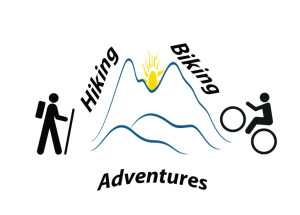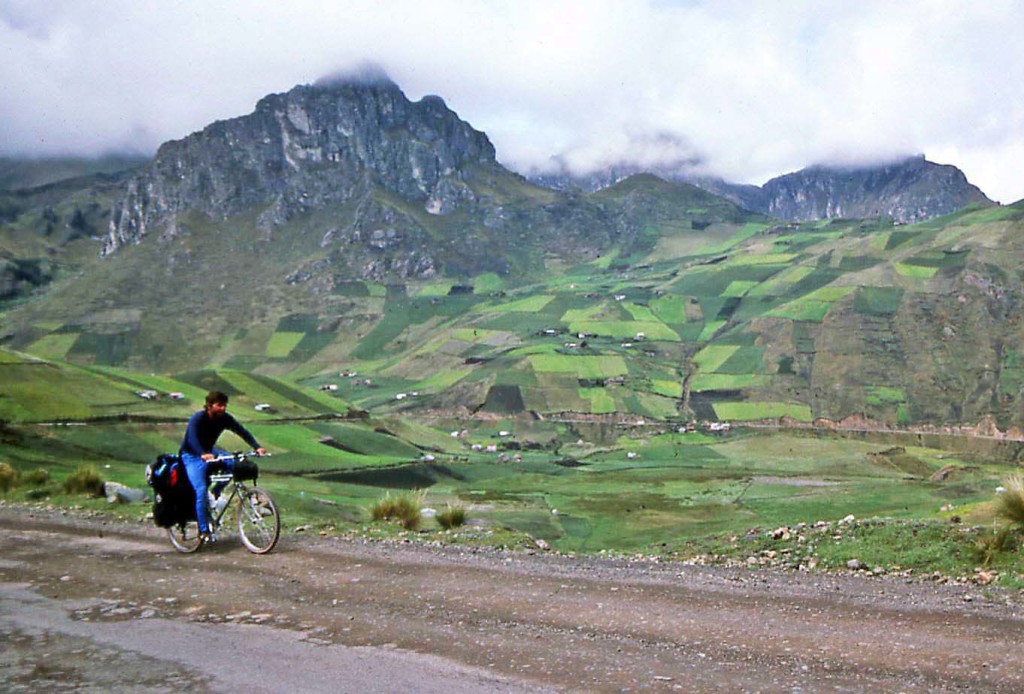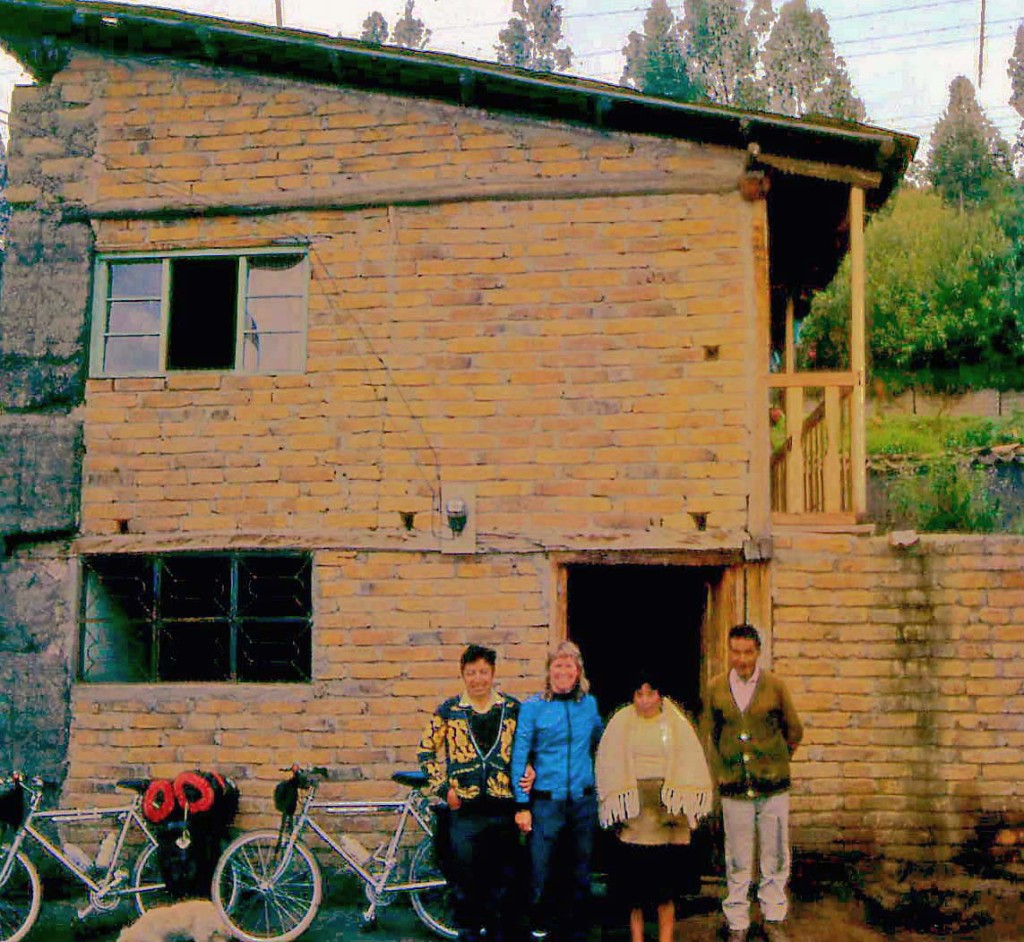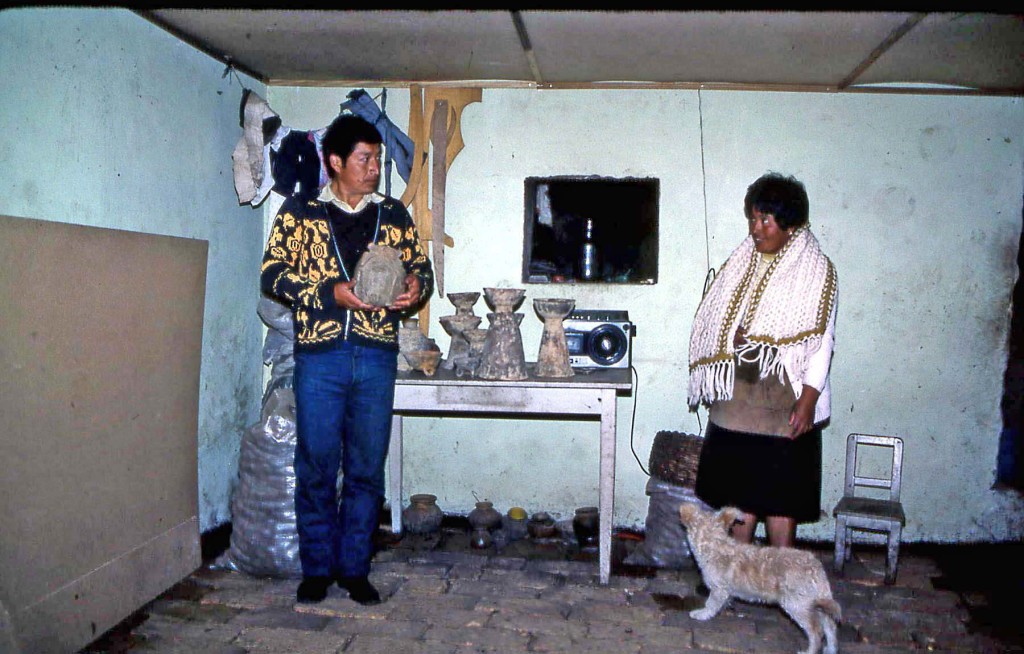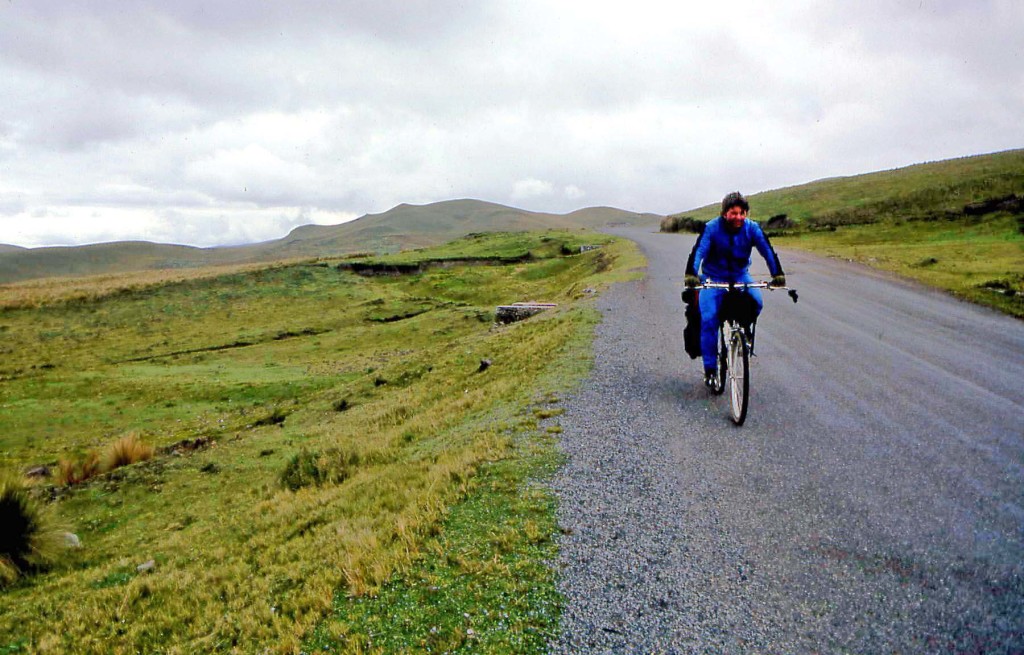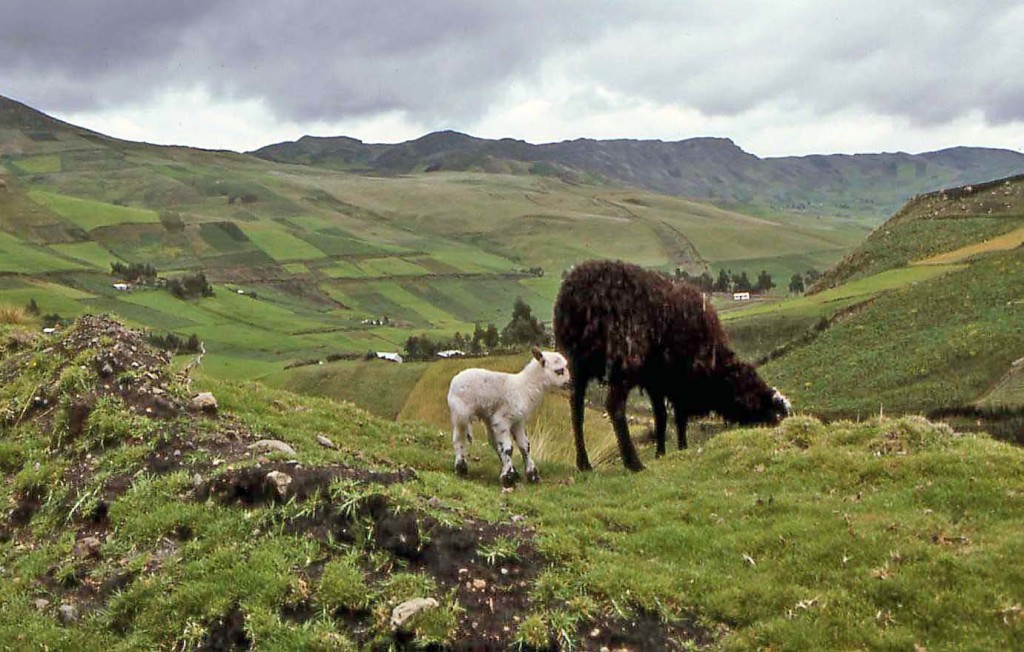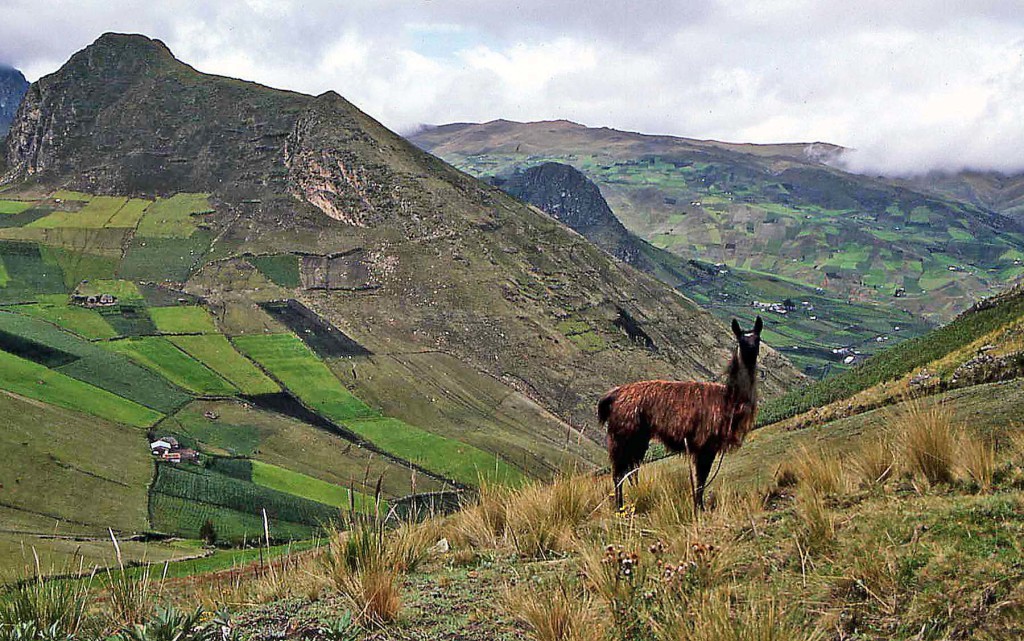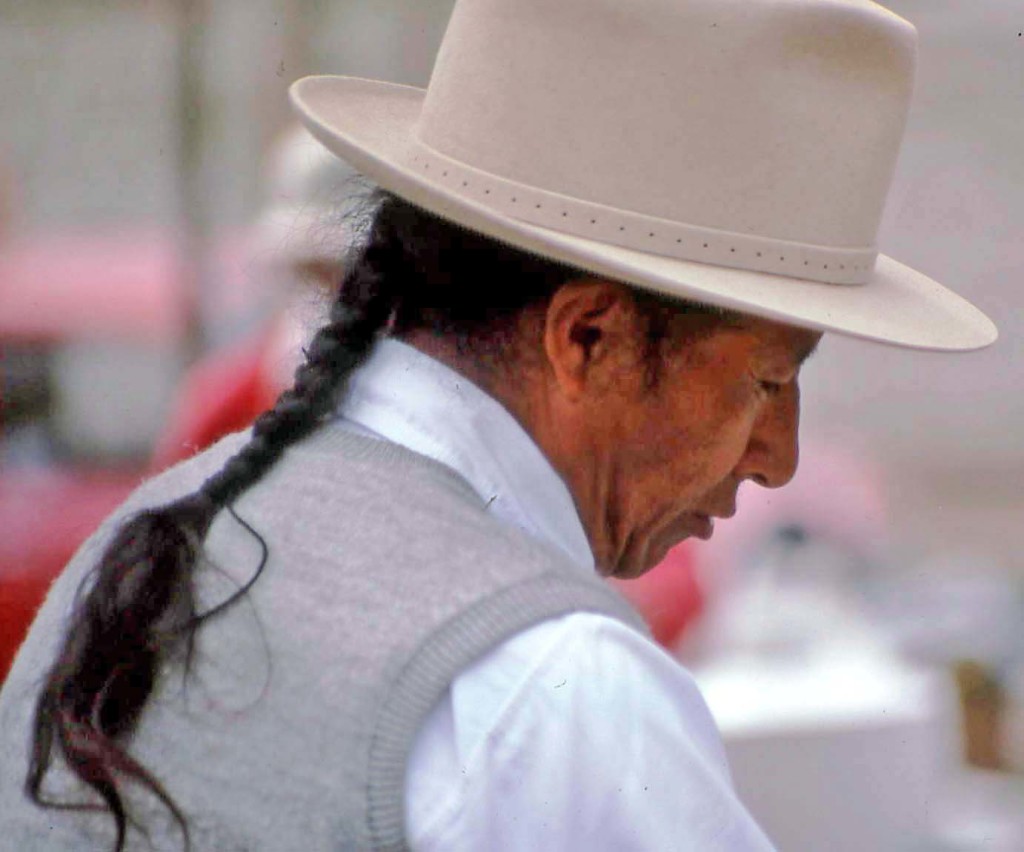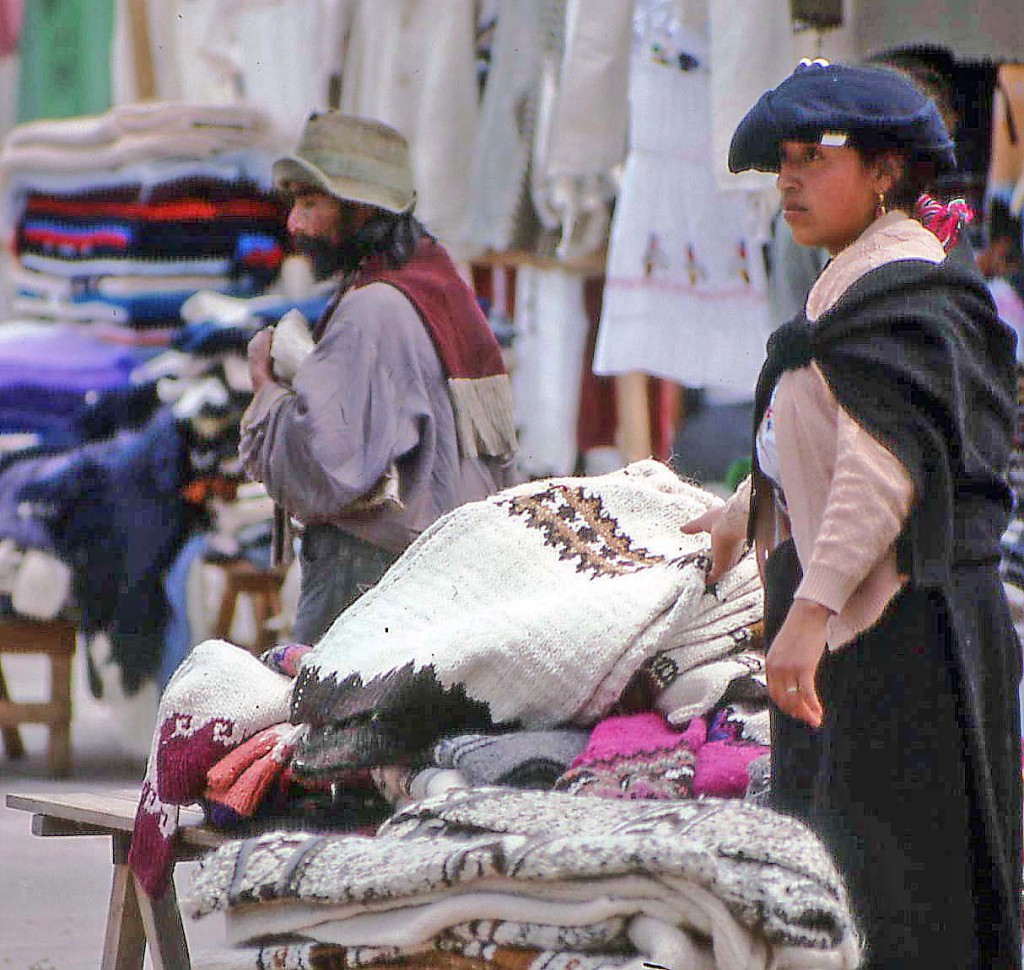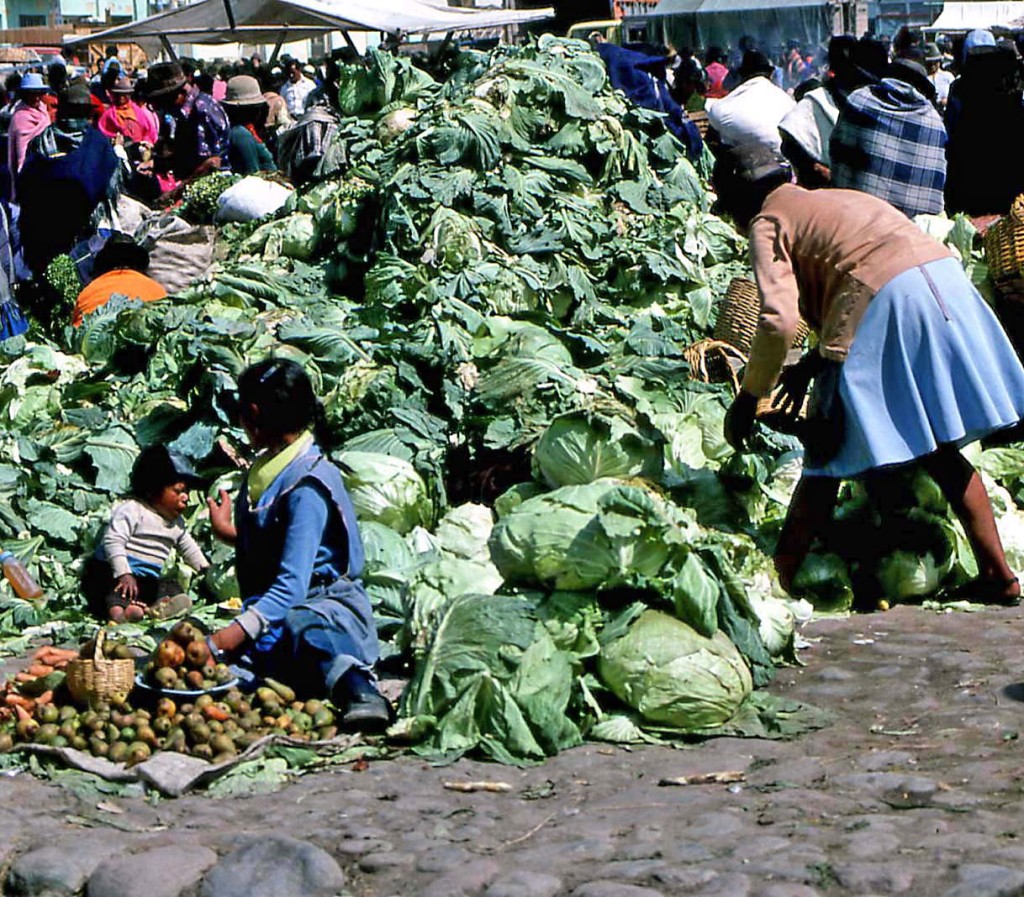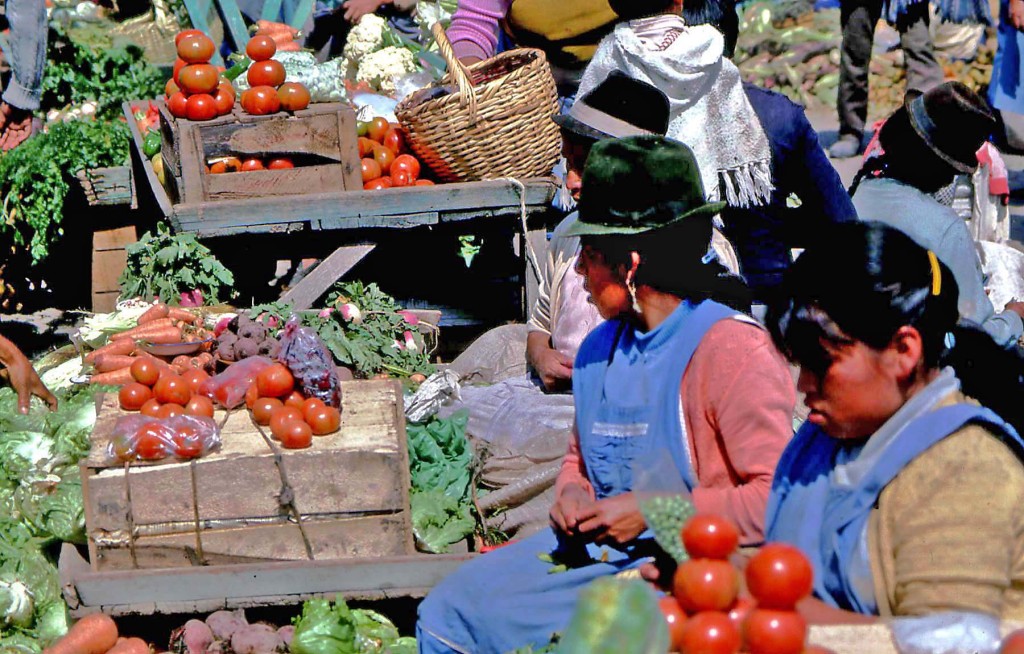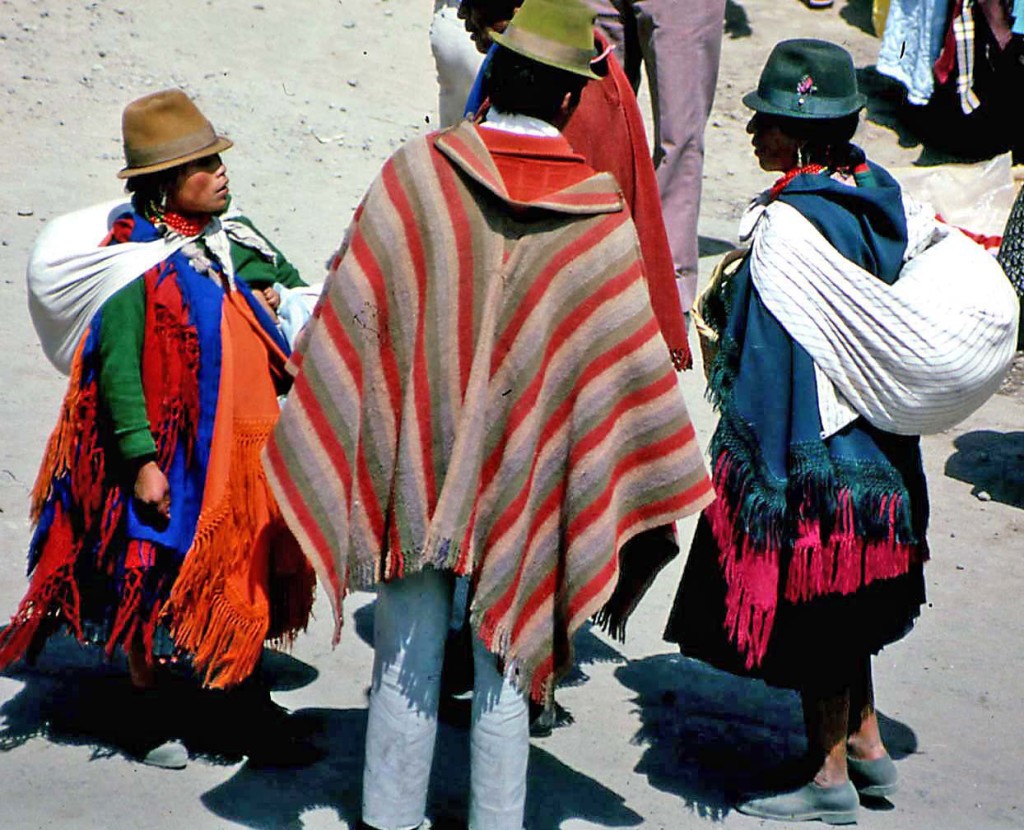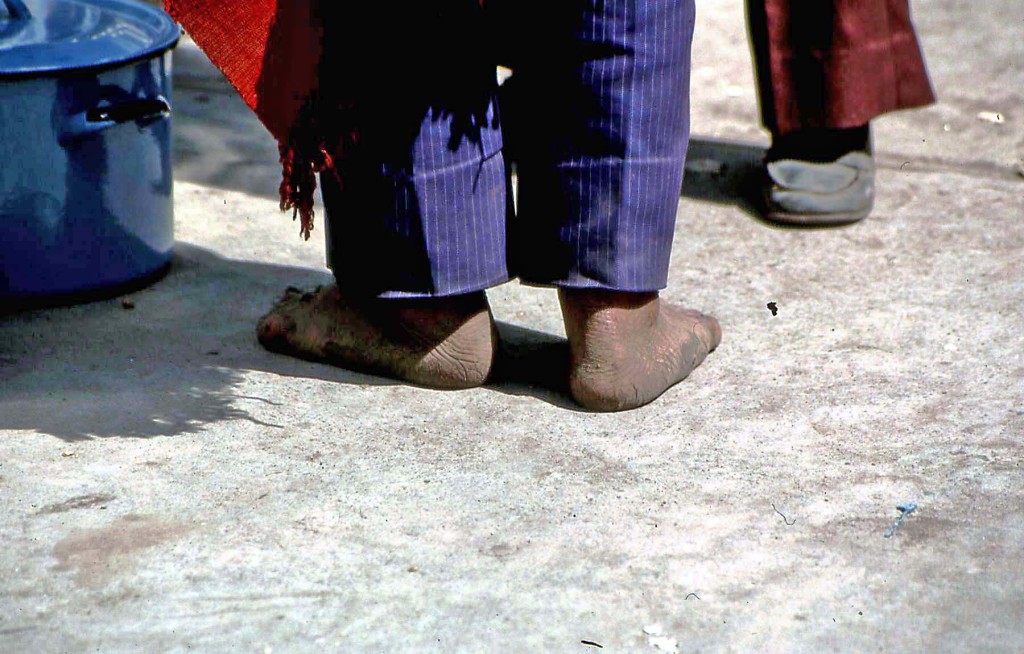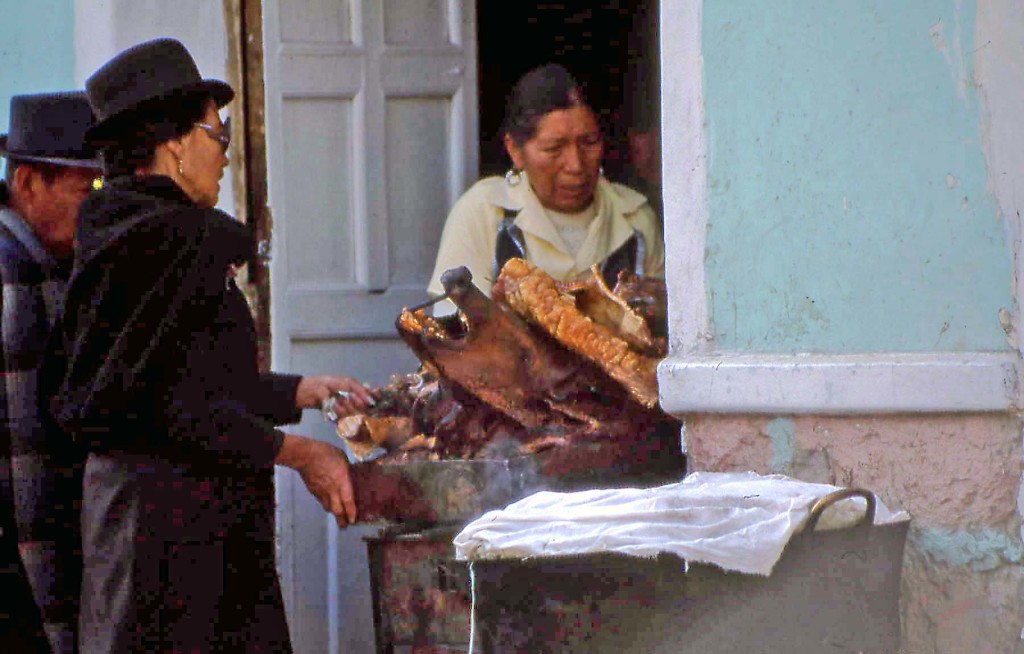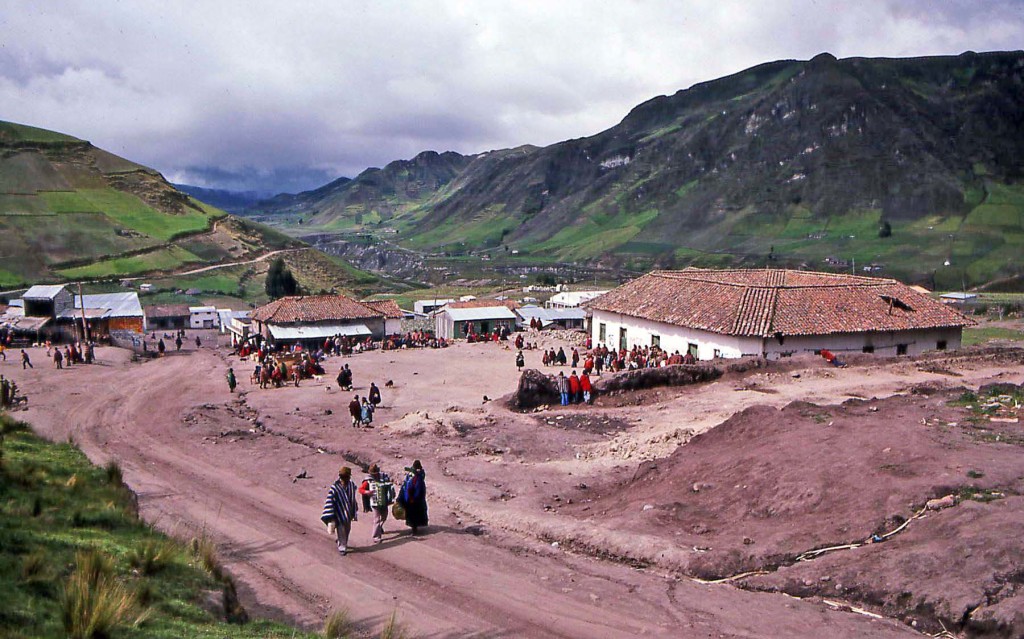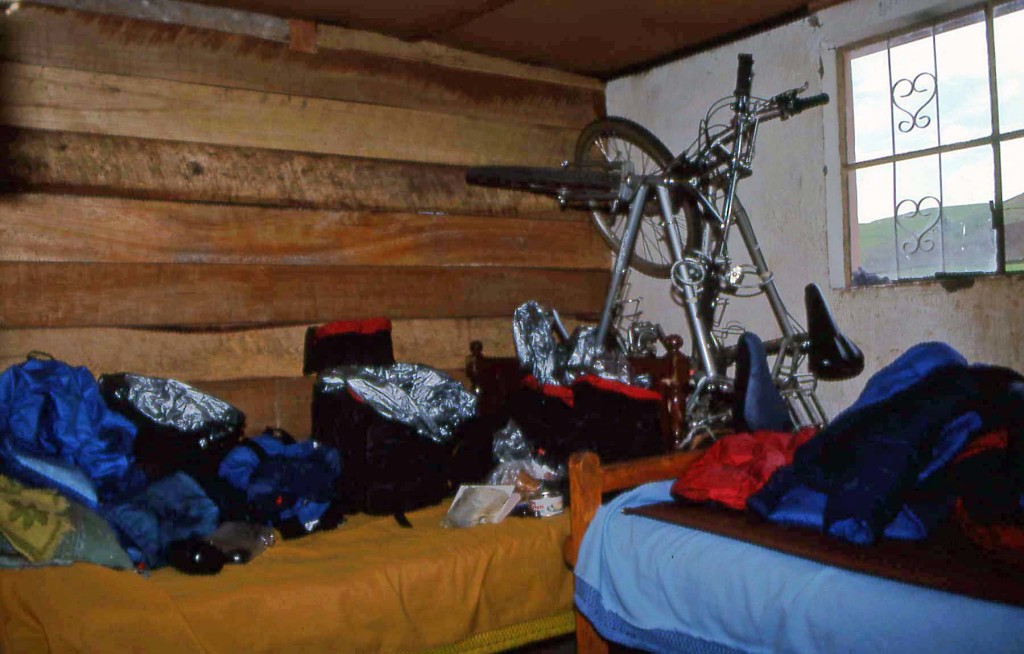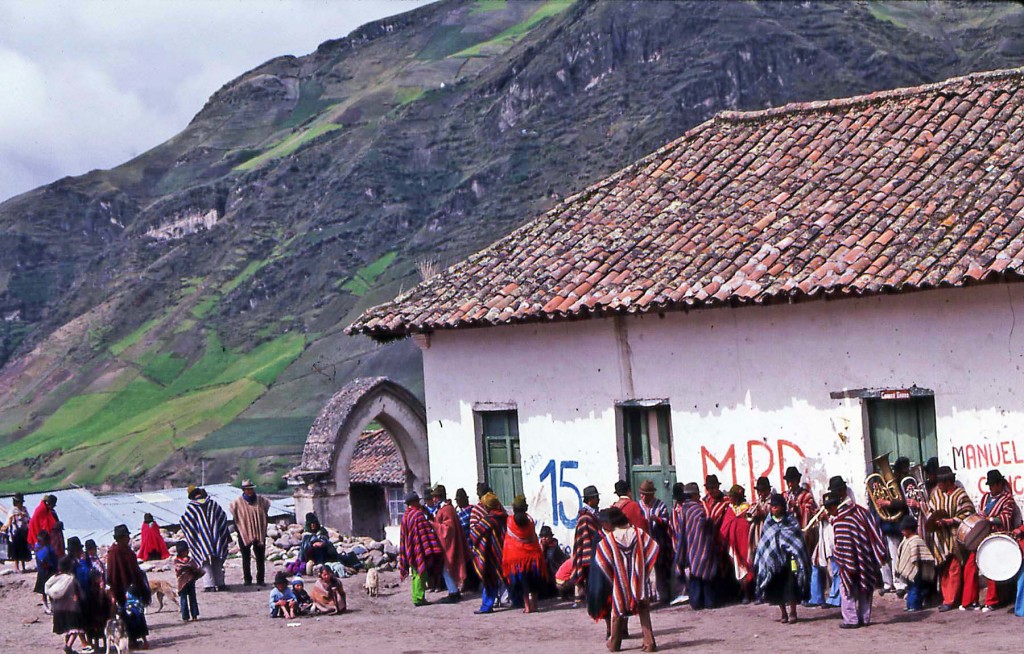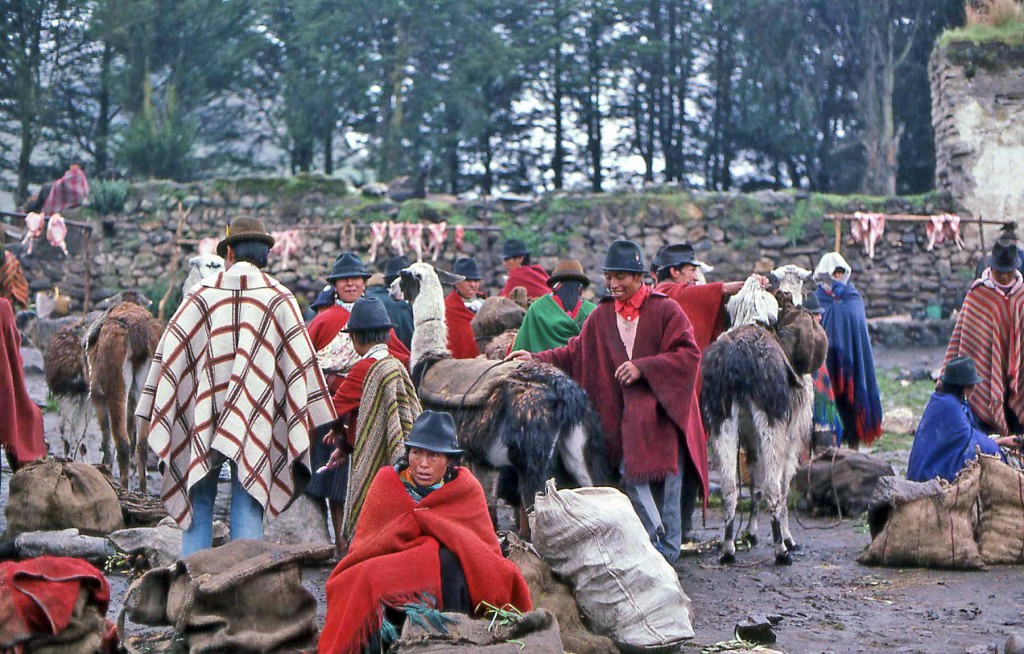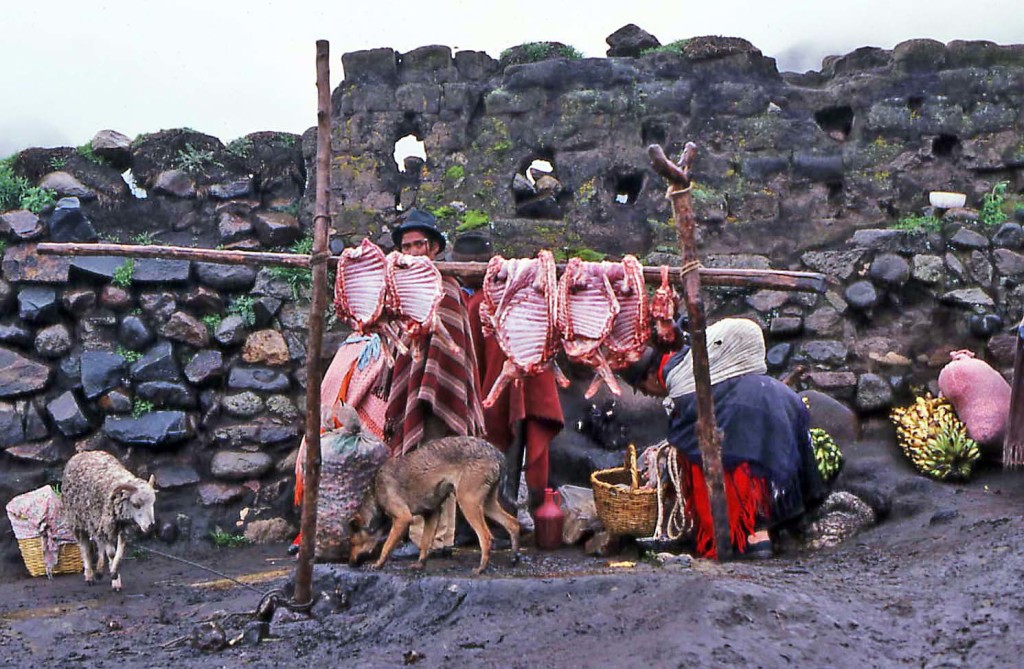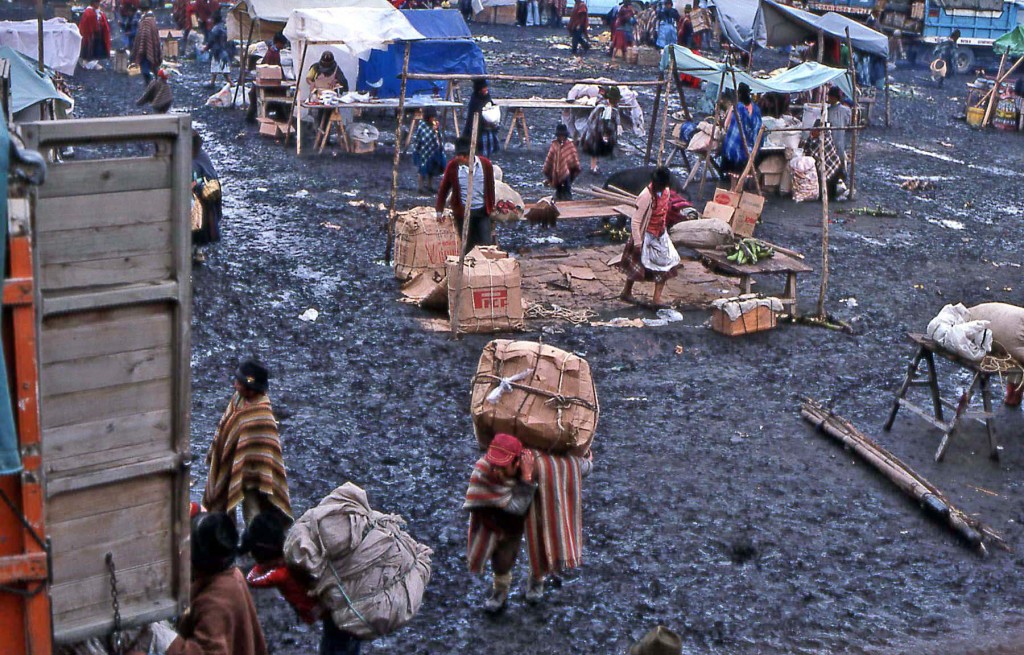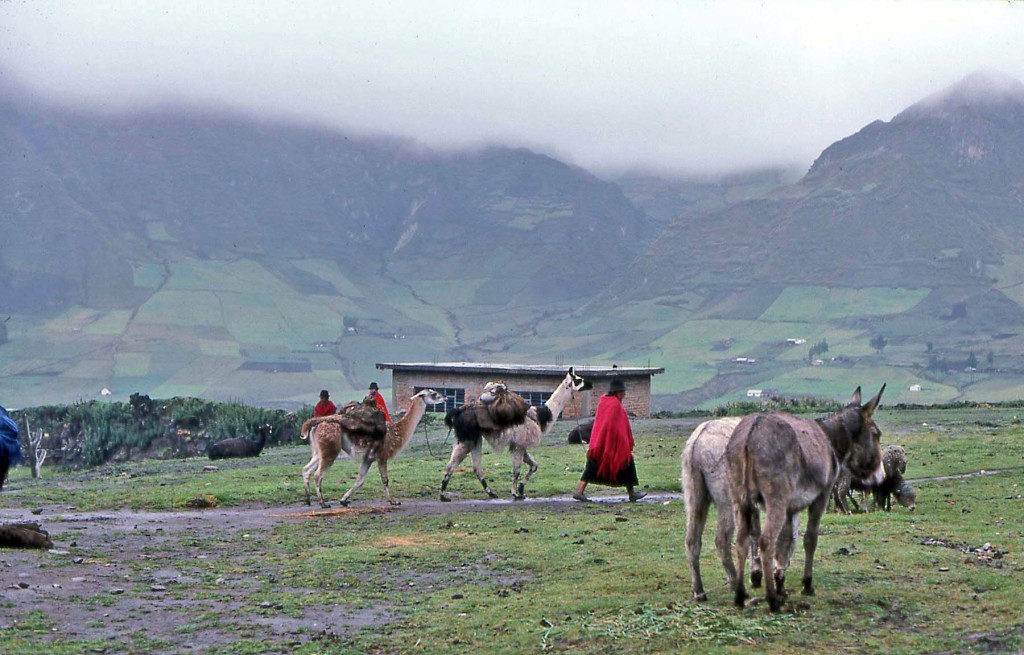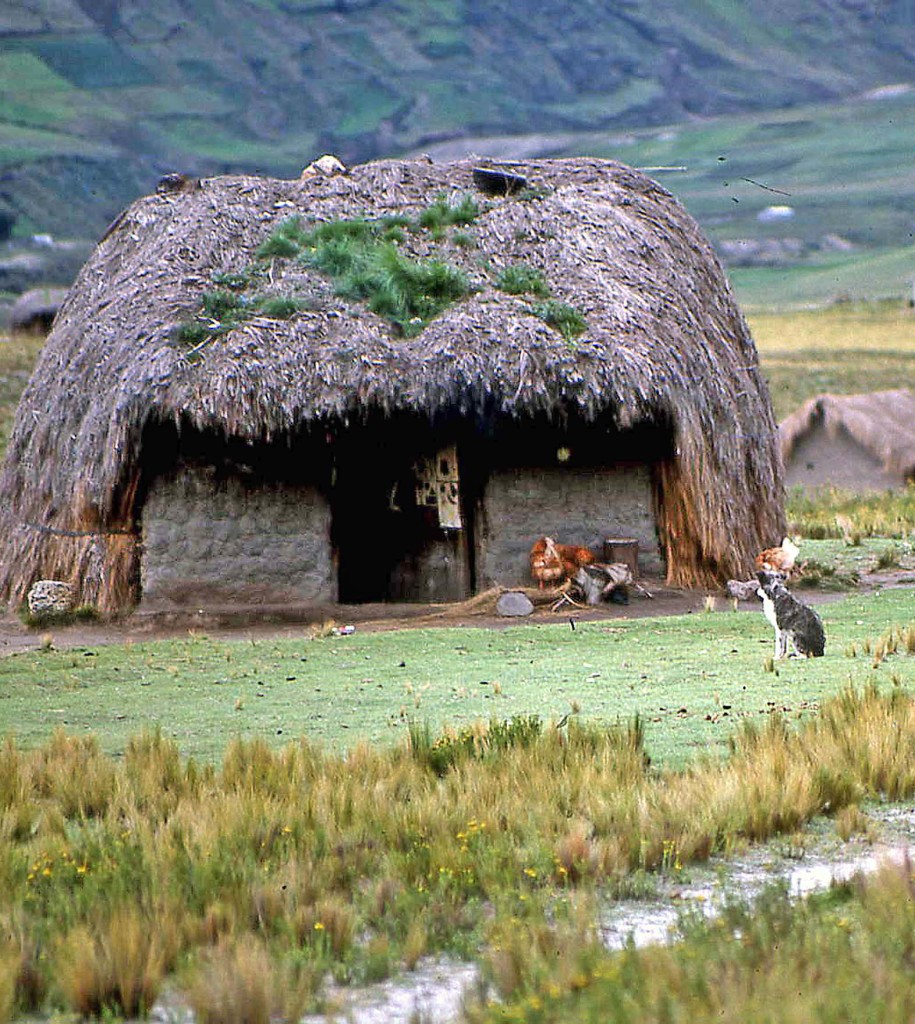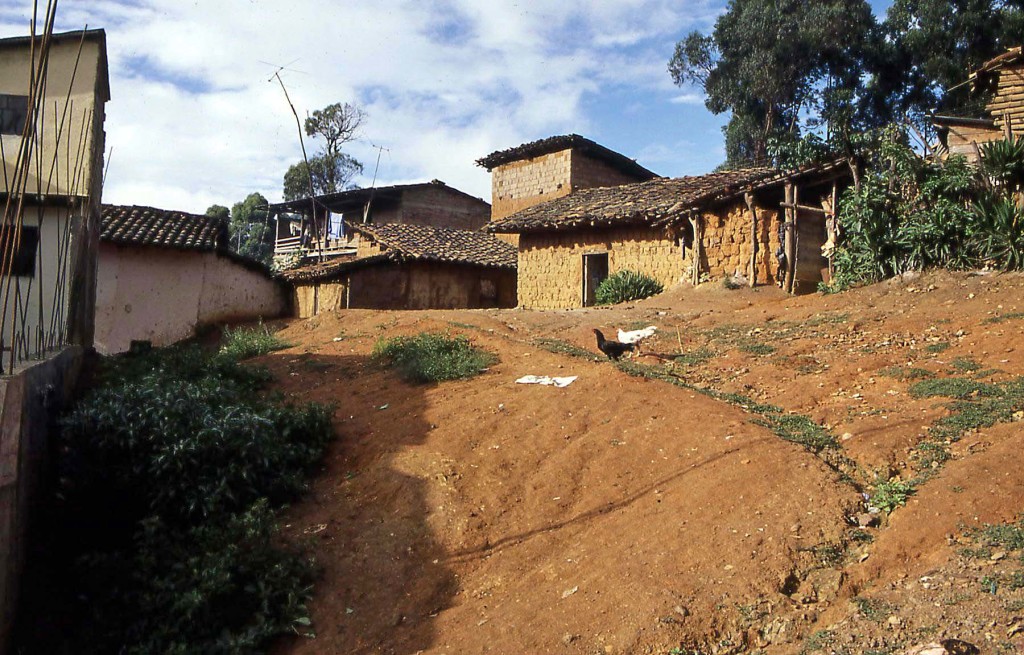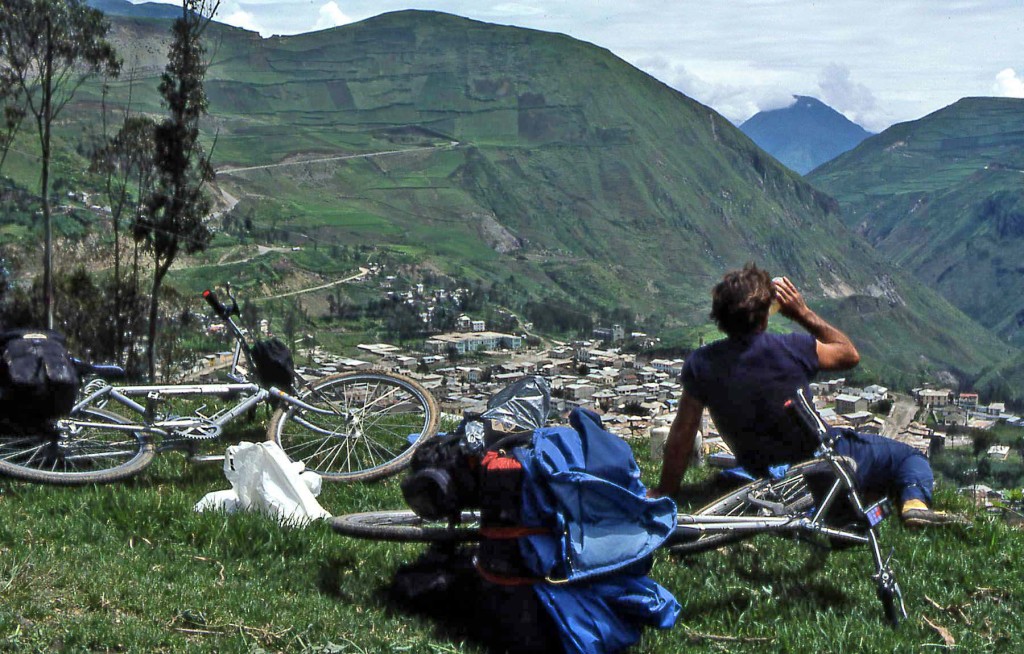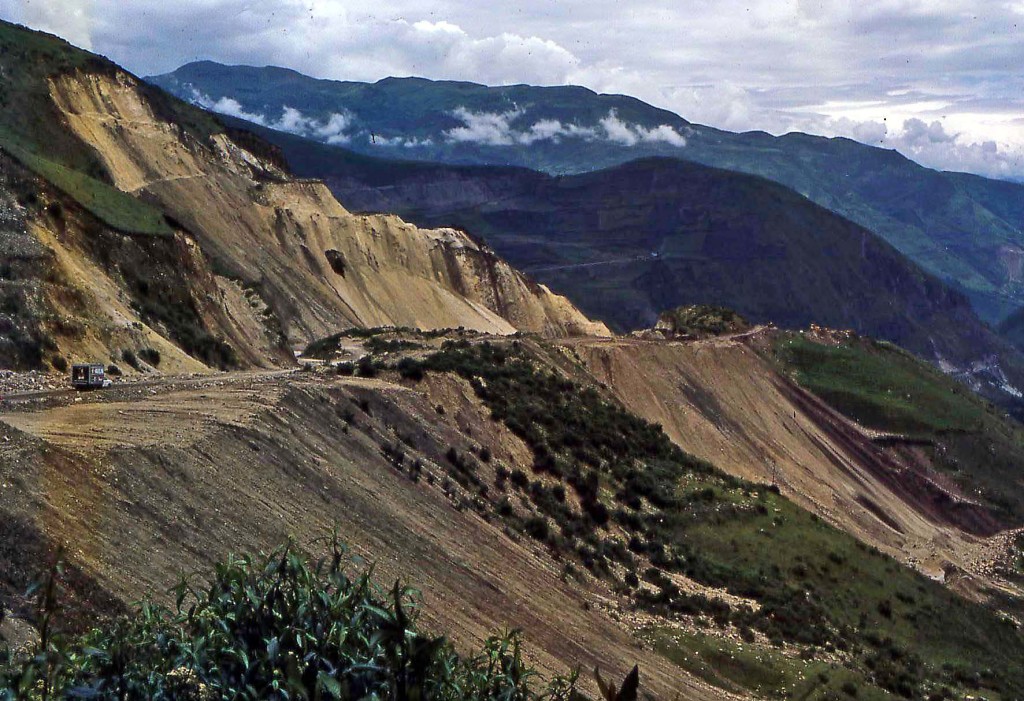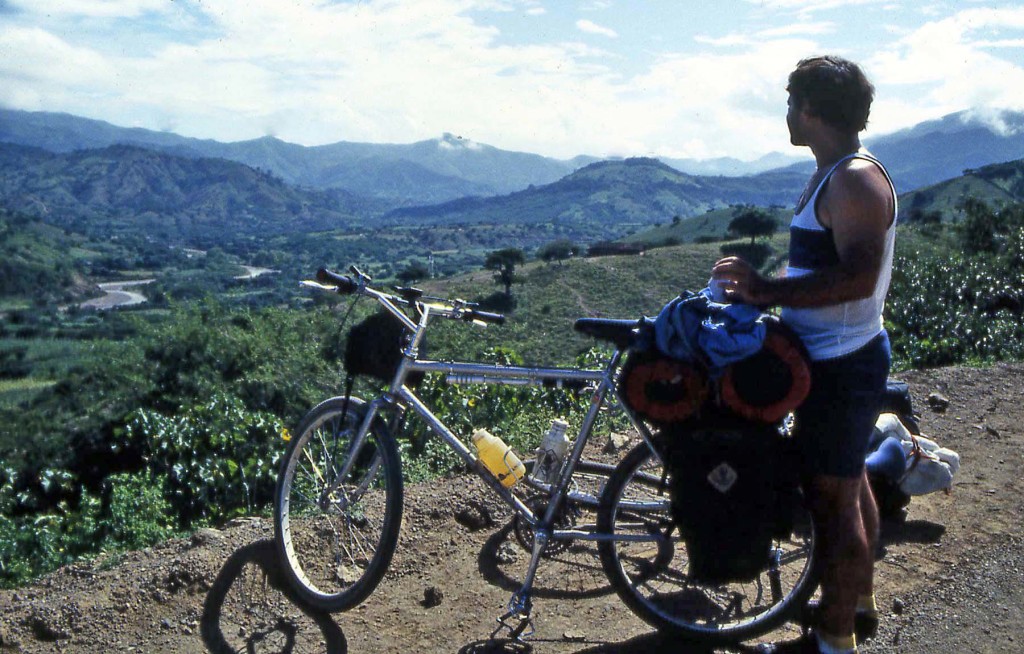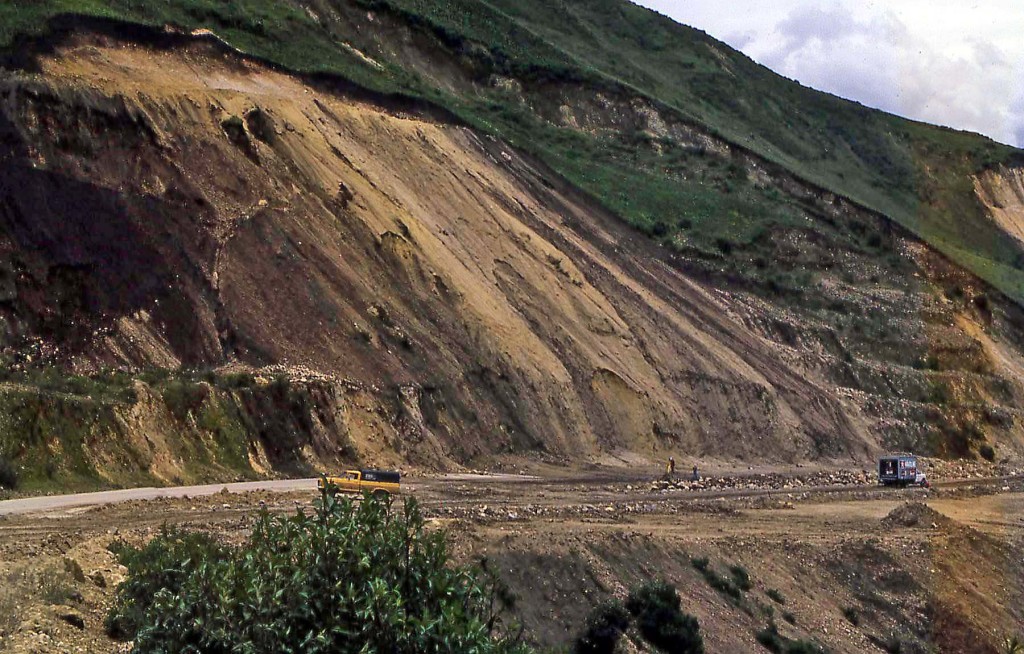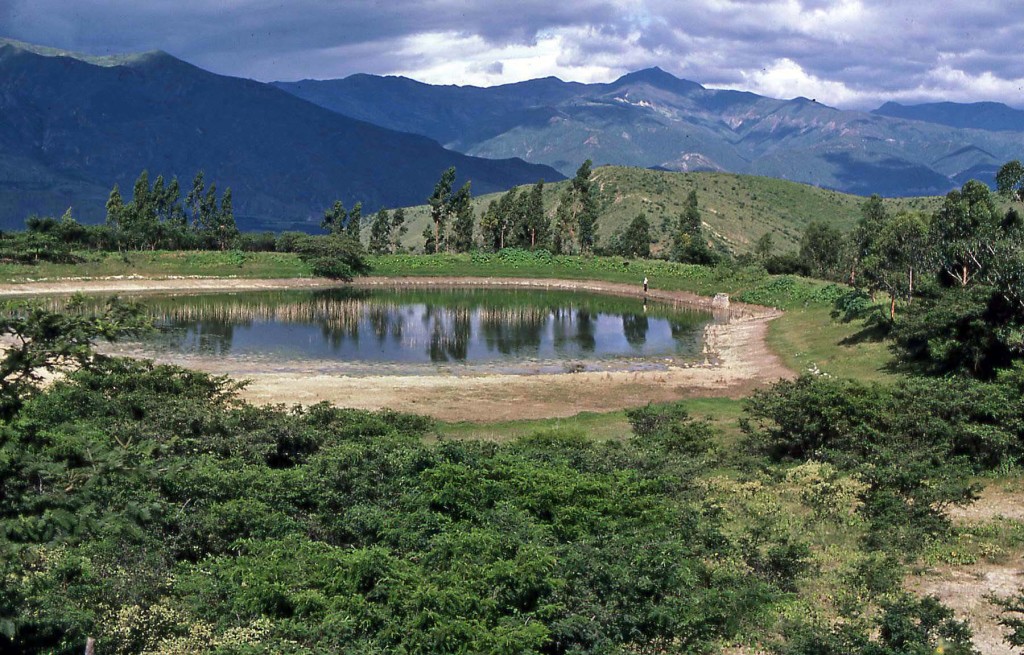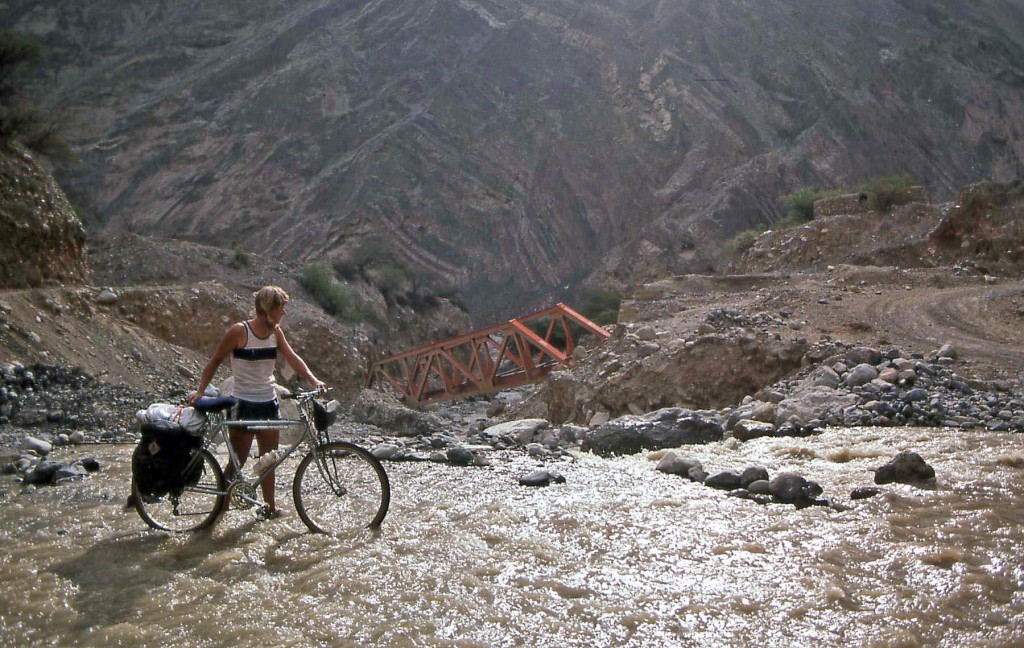Bicycling
Ecuador
Page Contents
- Ecuador
- Tulcan to Otavalo
- Otavalo Market
- Saquisili Market
- Saquisili to Latacunga 43 miles: 17 up, 26 down
- Latacunga to Banos: 72 miles
- Banos to Riobamba-53 miles with 30 uphill
- Riobamba to Guamote- 30 miles
- Guamote to Alausi- 30 miles up and down
- Alausi to Chunchi-35 miles
- Chunchi to Cuenca-90 miles by bus
- Sightseeing in Cuenca
- Cajas National Park
- Cuenca to Loja-120 miles by bus
- Loja to Catacocha-50 miles
- Campsite to Catacocha
- Catacocha to Macara-60 miles gravel
- Macara and crossing into Peru
“Welcome to Ecuador. It isn’t like Colombia; you are safe here,” said the border police as we pedaled up to the gate.
Tried all three banks in town and none would change American Express travelers checks.
The tourist bureau had no maps of Ecuador; they cost the government too much to print up. Left town stopping at all the gas stations but no maps. Started up an 8 mile hill going from 3000′ to 11,000′. Everything is very green.
We spent about a month and a half in Ecuador biking, hiking, doing jungle trips & sightseeing.
Bicycling Ecuador was extremely difficult at high altitudes and up very steep gradients.
In southern Ecuador, landslides, mud and rain were a daily challenge. We took a bus to get through the worst of it.
Ecuador was a highlight of our adventure.
Two parallel mountain ranges cut north-south for 240 miles through the center of Ecuador. Between these ranges are ten hilly rungs that join the ridges together like a ladder. Spread between the rungs are basins with floors ranging from 6,000 to 10,000 feet.
More than 30 volcanoes, 8 of them still active, line both rims of the Sierras.”
We hadn’t cycled far before meeting Juan. He was walking home. He had been cutting brush; his wife gathered grass used to flavor tea.
He invited us to spend the night at his home.
Several of Juan’s friends stopped by.
We were seated on the bench, a place of honor.
Bicycling Ecuador
Tulcan to Otavalo
On the dirt floor rested one wood bench along a blank wall; one small wood table hovered in the corner.
The room had no windows.
Back to the house, Juan’s wife served us dinner of potato and onion soup. It was delicious and I’m sure the best food they had. We of course were still very hungry and craved more carbohydrates. After dinner the friends stopped in again.
Among the colorful people was an old Indian with no upper teeth, his left foot sticking through the side of his boot where the stitching had broken loose.
I asked for the bathroom. Juan’s son walked me about 280 yards down the road to the school house and only village bathroom. It was filthy and dark. Went to bed in the upstairs part of the house. Juan laid grain sacks on the floor for us to sleep on.
When we woke in the morning there were 5 other people sleeping in the room.
After leaving Juan’s house, the serious climbing towards Quito began. We allowed two days just for the ascent. It was 50 miles…all up. The road wound like a cobra floating out of a snake charmer’s basket.
Because of our heavily loaded panniers and the rapidly thinning air, “progress” was hardly an appropriate description for what we were doing.
It was barren, vast, and lonely…until we rode over the top. Aren’t all summits worth the climb? The great mountain peaks surrounding immense tundra-like meadows reminded me of Alaska, with volcanoes replacing glaciers.
Bicycling Ecuador
Otavalo Market
Otavalo, not Quito was our real destination of interest.
Every day in Otavalo is market day.
By 6 am most the Indians have brought their wares to town to sell. There are three separate areas: produce, livestock and woolen goods.
The Indians are beautiful people, their features are full and round.
The men wear one long braid of hair, the women tie their long hair up under large black hats.
The women wear blouses that are hand embroidered with many colors, full length skirts and embroidered black shawls.
Note the local beggar in the background.
There are poor Indians who beg. They smile, shake your hand and bid you good day. Then they put their hands together like praying and bow. It is only very old people, no children. If you say no, they go away. If you give them a penny they bow and say thank you. The Indians give to the beggars too
The food market is something else. One entire park square is devoted to food stands, fruit, vegetables, meat, avocado, tomatoes, cucumbers, carrots, cabbage, bananas, peppers, beans onions and many things we had never seen. When buying some tomatoes, the lady said 30 cents a pound.
I looked around for a scale. She picked up three tomatoes in her hand indicating 1 pound. Her hand was obviously the scale.
Thousands of un-gutted fish are sold from the back of a huge truck..They sit in the sun all day. In several places women are gutting them on the ground then frying them up to sell. Files of cabbages, a whole harvest lay out in “the sun, the stench is incredible.
No one washes their hands.
The woman wiped her hands on the apron that covered her skirts, then picked the remaining meat from the boar’s scull that graced her portico.
I couldn’t believe I was standing in line, conspicuous in my Lycra, waiting a turn for boar’s brains.
Saquisili, our next destination, is not to be found on most maps. The town plays host to the largest indigenous animal market in Ecuador.
It lies in the heart of the western Cordillera at 12,000 feet.
“Is there a place we can sleep for several nights?” I queried the young group.
“Si, si,” one of the boys replied as he jostled himself to the fore. “We have a hotel. I will take you there.”
We stopped in front of a crude wooden ladder. I looked up to see a trap door. Puzzled, I asked the boy again if there was a place to sleep.
He climbed the ladder, opened the trap and disappeared. We followed, still wondering. He led us into a narrow hallway flanked with four doors. He pushed the first door aside. Two single beds crammed into the corners of the room left just enough space to enter. I asked him the location of the bathroom.
“Donde quieres,” he replied, wherever you want. I opted for a snoop around the hallway as I really wasn’t certain I understood his meaning. Nothing. I climbed down the ladder and rounded the corner of a row of houses. Standing at the edge of the village fields,
I saw a woman, covered by layers of heavy wool skirts, squatting over an irrigation ditch. The full meaning of donde quieres sank in. I waited until dark.
Early the next morning, a band began to play what reminded me of a catchy, laid-back Sousa march. There were 3 trumpets, 2 tubas, 2 big drums, and cymbals. It was a festival. Men, women, and children danced, each in their own circle. Whoops and hollers accentuated the beat.
As the day wore on, the band continued playing…the same tune over and over. Eventually the dancing (with a little help from the local liquor) took its toll.
Men and women alike fell to the ground where they were left to rest.
“What did this festival celebrate?” I asked a man later that evening.
“Un dia del descanso,” he replied, a day of rest.
The next day, outlying farmers brought their livestock to the central village to sell. We wandered about, misfits in our polypropylene and Gore-Tex amidst a world of nature’s provisioning. We had traveled through a time warp; the rain and fog intensified the faraway feeling.”
At dusk, goods were loaded onto the llamas and the market dissolved. Next week for the villagers, this scene would repeat itself. Next week for us, the rich details would be memories, thousands of pedal revolutions away.
Bicycling Ecuador
Saquisili to Latacunga 43 miles: 17 up, 26 down
High clouds meant possible clearing so we prepared to go. Excited about biking out because it is so beautiful. Went to our favorite kitchen again for breakfast but as usual weren’t quite sure what if anything we might get. Asked for breakfast. She said sure, in a little while. Pots of different things cooked furiously on the fire. We expected corn like the days before but nothing came. Finally, I asked for hot milk. She brought some stale bread; after about an hour, we decided to go.
People are marvelous but we still haven’t figured out the proper method of getting things.
The local bus driver honked the horn repeatedly urging all riders to get on. As soon as they were all loaded he came into the kitchen for coffee. All the people in the bus waited patiently for 20 minutes while he drank.
By now most the people of Saquisili knew who we were and came to wish us a good trip. Other foreign travelers we met had made the remark it was difficult to meet the Indians. We were under the impression these foreigners travel too fast and did not bother to take the time necessary.
We had no problem getting into conversations, even with our poor Spanish.
The ride down to Latacunga can never be forgotten. Beautiful views, no traffic, llamas, sheep, burrows, thatched houses, friendly people, We have seen what we hoped to see, and realized that any and all side trips are more rewarding than we hoped.
The scenery on the Pan American highway is spectacular but the traffic is heavy
but we found our most treasured experiences were in the back country.
Bicycling Ecuador
Latacunga to Banos: 72 miles
Ambato is a big city, 110,000 looking a little like Hong Kong with its narrow streets and heavy traffic. It was laid out like a maze, hundreds of streets going nowhere. We didn’t want to stay in the city so took off at 2:00 for Banos 25 miles away. Strong headwind came up; so strong we had to pedal down from 12,000 feet to 7500′ with more effort than downhill should require.
Steep canyon walls falling into the wild Pastaza river. Many rock and mud slides.
Banos has to be the perfect spot in Ecuador.
The cold refrigerator stocked, cokes, beer and ice.
Went out to dinner last night. Mike had a thick steak that he picked out of the fridge himself; four servings of French fries, salad and liter of beer for cost $1. I had a vegetable pie that was as big as a dinner plate chocked full of goodies for 45 cents. We sure like Banos. Since the beginning of the trip it has been the first place where we felt we could really relax and unwind.
Bicycling Ecuador
Banos to Riobamba-53 miles with 30 uphill
The book says we rise only 3500 feet but that was difficult to believe. We climbed all day long in sprinkling rain. Our route followed a fantastic river canyon all the way. In Riobamba, the rain was pouring down again. Found a really nice hotel with a big ground floor room. Finally, an easy place to put the bikes.
The bed, however, hard as a rock which has been typical of most hotels.
Sky is overcast. We didn’t leave till 10 am. By 1 : 00 it had turned into a downpour. Luckily we arrived at a village seconds before it cut loose.
They were having a street fair and people were dragging their screaming pigs by one leg as they went to market.
Arrived in Guamote which has to be one of the most basic towns I have ever seen. Buildings are falling down, people are very ragged and unwashed, wrapped under many layers of torn clothing. Street food stalls sell the worst looking stuff.
Sanitation is unheard of; women handle pig guts then wipe their hands on filthy aprons before mixing mashed potatoes by hand.
There was only one hotel in Guamote. We were wet and very cold and too tired to put up the tent, so we took a room in the hotel. This was the filthiest we’ve experienced.
Built of stone and rotting wood, the whole place reeked of urine and mildew.
Up a decrepit flight of stairs to a tiny room with two army cots. The place was papered with old newspaper and magazine pictures, It was barely big enough to enter but we got us and the 2 bikes in. Stacked them on one bed and Mike and I tried to survive the other bed together. Ate cold sardines for dinner as our MSR multi-fuel stove was clogged from using gasoline and we didn’t have the energy to clean it.
There was a piss pot outside our door which I used instead of going to that awful bathroom.
Some of the most beautiful cycling we’ve had. Road up and up to the high Paramo or grasslands above timber line. Barren country but beautiful. Stopped at a tiny little town for lunch; lovely friendly people as usual. Bought some crackers and sardines in the store and sat on the porch to eat. Everyone was interested in watching us. One man was bold enough to ask who we were and what we were doing. He was well educated and told us a lot about the area.
Finally dropped over the edge of the Paramo and descended into a myriad of valleys, This is the beginning of what is called the southern sierras. The roads are not well maintained and most the traffic turned off to Guayaquil. We had it to ourselves.
There are huge landslides everywhere. Road frequently closed or detours made. Descending into Alausi is breathtaking; we stopped for an hour to enjoy the view and sun.
Bicycling Ecuador
Guamote to Alausi- 30 miles up and down
Flies are abundant and eagerly contaminate every dish as they fly from street garbage to your breakfast. She also has an entire pig, head and all, from which she tears off various parts with her hands for different dishes. Sometimes cooked chicken as well just sits out waiting for someone to order it.
It’s the original fast foods.
Accommodation like a palace but bathrooms still basic.
Don’t mean to belabor the point but all of South America so far smells like urine.
The tiniest piece of meat you ever saw is served, usually the wing or back.
For breakfast this morning in Alausi, we ate at one of the outdoor food stalls as there were no restaurants open. These stands are common all over South America. A woman in a space about 4x4 sets up a wood fire in a pan similar to a wok.
She has a huge pile of mashed potatoes which she rolls in her hands to make pancakes and fries them in oil, She fries eggs too.
We rode a 10 mile side trip along a canyon where the famous train goes to Guayaquil,
We are biking through some of the most beautiful country we’ve seen.
Back on our main route to Chunchi, the beautiful scenery continues and still there has been no traffic.
The roads are cut into cliffs; there are no guard rails, no vegetation to break a fall.
Arriving in Chunchi, the fog has become so thick we can’t even see. We spent 4 hours circling round town looking for a hotel.
The outside of the buildings are plain, and usually very unattractive.
It’s raining. Fog is thick and two weeks ago a huge landslide wiped out the road ahead and killed 11 people. Come to find out there is a 12 mile detour which descends and climbs 2000 feet on dirt road.
With 45 miles to the next town plus the detour, heavy rain, gravel roads and steep climb we decided to take the bus. We’re glad we did.
Bicycling Ecuador
Chunchi to Cuenca-90 miles by bus
Rain continued all day so instead of stopping at the small town of Canar we decided to go on to Cuenca, third largest city in Ecuador, for a good hotel, bath and hopefully some good food. Arriving in Cuenca at the bus station, we were immediately impressed by the cleanliness of the new building with shops, restaurants and information booth. Quickly we seized upon the opportunity to get a map of the city and find out about hotels. But they didn’t have maps! Thumbing through our guide book I saw an address for the tourist bureau and asked for directions. Riding about 10 blocks, we reached the central square and knew we were close.
Seeing a policeman, we asked for the exact location for the bureau de tourismo.
Along the way we asked 5 different people for the officina de tourismo. They all pointed us up to the square where we met the policeman..
True to nature, locals, if they don’t know what you want, they will answer you anyway.
Here we are in Cuenca, a tranquil city with lots to do. First rate American movies, good food, beautiful countryside, hot pools, Inca ruins, museums and folklore concerts.
And the best hotel room we’ve had. $4,50 for carpeted, private bath with hot water, large double bed and windows on the top floor of a hotel, and a place to cook with our stove.
There were no large markets such as we knew them (Safeway). Most of the markets even in the big cities like Cuenca were tiny and carried a small amount of canned goods and were very expensive. The locals bought all their food in the open street markets where the prices were cheap and there was a big variety of everything fresh. Nothing like peanut butter, or convenience foods that were easy to carry in the panniers.
Bicycling Ecuador
Sightseeing in Cuenca
It’s Saturday night. We decided to splurge and go out to a restaurant mentioned in our book. It was a very nice atmosphere.
I ordered a steak medium rare. It was well done.
The clerks at the hotel assured us they would wake us at 5 am to catch the 6 am bus to the famous mountain park.
Only one bus a day.
Bicycling Ecuador
Cajas National Park
Got ourselves up to catch the bus to Cajas National Park. The bus was ancient, totally falling apart with every bump. The driver would stop as long as ten minutes at each stop as people loaded on beds, sewing machines, lumber, anything. One time he backed up a block while someone loaded the contents of his garage.
It was 20 miles to the park and took 2 hours.
We waited in the freezing rain, freezing.
There is a hut at the park where you can spend the night. But because it was so cold, we decided to go back to the hotel. The hut had no heat but did have a cook stove. We nearly froze to death. Finally the rain stopped so we went out to investigate the park. It’s kind of like the moon at 14,000 to 15,000 feet.
Bicycling Ecuador
Cuenca to Loja-120 miles by bus
The rain was relentless and very cold. We decided to get out of the mountains and save our biking for better conditions.
The roads are incredible. The only thing that keeps them in place is the will of God.
Bicycling Ecuador
Loja to Catacocha-50 miles
A reasonably nice day so back on the bikes again. Feels good. Don’t know what to expect of the weather. Sixteen miles uphill into the clouds.
These long hills are really tough.
Reaching the valley floor which we crossed in less than 2 miles we started up the other side.
Progress is painfully slow but we’re glad we chose this route;
Bicycling Ecuador
Campsite to Catacocha
Surrounded by school girls in San Pedro. Very kind, interested and friendly. Taught them English from their lesson book while Mike shopped. All school children in Ecuador wear school uniforms. The parents have to pay for them as well as education costs. There is no free public school. Many people are thus uneducated.
Again magnificent scenery, long 16 mile climbs, 12 mile descent on dirt road.
Hundreds of burros everywhere. Green and blue birds filled the air, Very steep 10 mile climb into town of Catacocha perched on the mountain top. Dead tired. And it always seems the hotel is on the highest hill. Surrounded by people with a band of children leading us, we found the hotel. Typical $2/night dump.
Went grocery shopping. Man tried to sell us eggs for 10 cents each. We usually pay 7 cents.. He told us transportation cost more.
First 14 miles wound downhill like a serpent. Countryside beginning to show signs of more dryness. Roadside stops for cold drinks. Don’t think the people have seen many gringos. Lots of attention and surprise. Road is very rough gravel up and down along the river.
Much to our dismay, we had several steep passes over intermittent mountains to cross.
We were lucky to come upon a lone house with a big porch and asked if we could spend the night.
Bicycling Ecuador
Macara and crossing into Peru
Anticipating our last day in Ecuador, we cast our eyes back up in the mountains and said thanks for a beautiful 2 months. Delighted by its people, thrilled by its scenery, grateful to have been allowed to climb its mountains though thoroughly worn out by them, we finally reached the summit and descended to the border with Peru.
Macara, described as hot and dusty was a mud hole from all the rain. Border towns are usually not the nicest places in the world and this was no exception.
A money changer picked us up as soon as we rode into town.
The money changers are all in league together and we don’t really trust them.
Usual border facilities: stopped at the Ecuadorian office to get exit permission. We asked the officer the rate of exchange. “Thirty-four,” he said.
Delighted, we offered to exchange with him, but in the middle of the transaction the money changer who had walked the three kilometers from town peeked through the window.
Thanks Ecuador for such a great time, Hope we see you again someday.
Copyright Material
All rights reserved. No part of this page may be reproduced or utilized in any form by any means, electronic or mechanical, including downloading, print screen, photocopying, recording, or by any information storage or retrieval system, without the prior written permission by the copyright owner.

